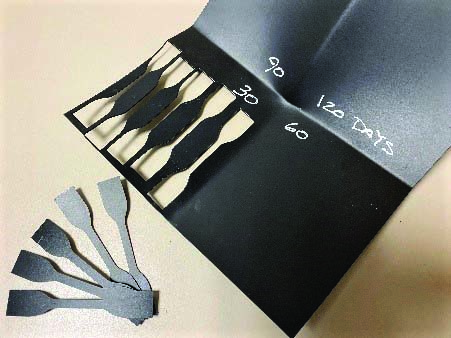
The accelerated aging process is based on the relationship between temperature and chemical reaction rate, in which the reaction rate increases as temperature rises. Most accelerated aging tests use higher temperatures to accelerate the aging process by representing real-time aging artificially. A good accelerated aging test should simulate real-time aging by using elevated temperatures to speed up the aging process.
Accelerated aging is often a specification endurance requirement for geomembranes, which will hopefully be related to real-time aging and actual service life performance of the product in question.
The anticipated service lifetime due to general material degradation is invariably asked by owners, regulators and designers, as well as the suppliers, manufacturers and installers that are involved. Other than intentional or accidental damage, the possible degradation mechanisms identified by Hsuan et al. (2008) are as follows:
ultraviolet radiation, oxidation, hydrolysis, chemical, radioactive, biological, migration and temperature.
Each mechanism only has relevance depending on the site-specific conditions as well as the specific type of geosynthetic resin and the formulation from which the geomembrane was made. If indeed a specific mechanism is involved, testing organizations have appropriate standards for such laboratory evaluation. The results of such testing, however, are usually of a “go-no-go” nature insofar as a final selection of material. They are not meant to be lifetime prediction methods in themselves. The most frequently asked question regarding all types of geomembranes is: “How long will they last?”
For most geomembranes, the answer is governed by the following: the formulation, fabrication, shipping and handling, proper design, installation, exposure environment and how well the geomembrane was maintained. To answer the lifetime question, the use of several different tiered elevated temperature incubations, followed by extrapolation to lower (presumably site-specific) temperatures, is utilized. Such Arrhenius modeling has been described by Koerner et al. (1990) and others; however, it cannot be routinely specified or checked.

Hence, we have a quandary. Do we have aging tests that can quickly assure us that we have durable geomembranes for most applications? For HDPE geomembranes we have relied on ASTM D5397 Stress Crack, ASTM D5721 Oven Aging and ASTM D7238 QUVA in the GRI-GM13 standard to satisfy this challenge. However, HDPE formulations have gotten so good over the past few years that these tests are no longer aging the material quickly enough. Therefore, we need a test that can age the material in less than 90 days and still be a good indicator of performance. We have dabbled with exposing these systems under stress (autoclave or burst); however, neither has given us the acceleration effect that we are looking for in the 90-day time frame.
Supported by the work on accelerated aging of HDPE geomembranes exposed to the leachate at 122°F (50°C) (EPA 9090 and then ASTM D5322), we believe that an incubation exposure may be in order. The change of properties as a function of aging can be assessed after 30, 60, 90 and 120 days’ immersion via tensile properties, differential scanning calorimetry and visual observations. It appears that predictable minor changes of the above properties take place under the experimental conditions with 10 ppm chlorine dioxide (ClO2) at 122° (50°C). This solves the vexing issue of arriving at a standard leachate and furthermore models a harsh scenario.
This practice also covers a procedure for the accelerated aging of geomembranes with double 180° folds (i.e., a star fold). See Figures 1–3 for the typical sample coupon and situation with the immersion container (mason jar) and constant temperature water bath. The types of geomembranes that this practice is focused on are ideally relatively thin geomembranes (less than 30 mil or 0.75 mm). The procedure could allow for the examination of the effect of ClO2 concentration (3, 5 or 10 ppm) at 122°F (50°C). The downside is that one can’t use higher temperatures due to the accelerated consumption of ClO2. Even at 122°F (50°C), the solution needs to be changed once a week so that proper concentration can be maintained (controlled via pH = 6.8 +/- 0.1 monitoring).
The performance trends show that the choice of resin type plays a key role in the longevity of the geomembranes. In addition, the stabilizer packages contributed to better resistance to degradation in chlorinated water.

Many factors affect the performance of the geomembrane, including diffusion, density and thickness. The simultaneously increasing material embrittlement and the consumption of active antioxidant molecules imply an apparent unselective reaction of ClO2 with the polymer and the stabilizers’ molecules. Moreover, the radical nature and the high reactivity of ClO2 leads to the formation of carbon-chlorine species, which are assumed to originate from degraded antioxidant molecules. Our results are consistent with those reported by Abdelaal et al. (2019).
Geomembranes have shown themselves to function well as landfill liners and covers. However, our goal is to never stop improving. Such laboratory accelerated aging tests are of value in comparing different products or different formulations of the same product. The process can also be used to contrast against a given specification. It is the Geosynthetic Institute’s intention to update GRI Standard GM24, Standard Practice for Incubation and Subsequent Evaluation of Single 180° and Double 180° Folding of Geomembranes, and GRI Test Method GM16, Standard Test Method for Observation of Surface Cracking of Geomembranes. These updated standards will be critical to address the new wave of high-performance geomembranes.
References
Abdelaal, F. B., Morsy, M.S., and Rowe, R. K. (2019). “Long-term performance of a HDPE geomembrane stabilized with HALS in chlorinated water.” Geotextiles and Geomembranes, 47(6), 815–830, 24, https://mc06.manuscriptcentral.com/cgj-pubs.
Hsuan, Y. G., Schröder, H. F., Rowe, R. K., Müeller, W., Greenwood, J. H., Cazzuffi, D., and Koerner, R. M. (2008). “Long-term performance and lifetime prediction of geosynthetics,” Proc. 4th European Conf.,
Edinburgh, Scotland.
Koerner, R. M., Halse, Y. G., and Lord, Jr., A. E. (1990). “Long-term durability and aging of geomembranes.” Proc. Waste Containment Systems: Construction, Regulation and Performance, R. Bonaparte, ed., Geotechnical Special Publ. No. 26, ASCE, 106–134.
 TEXTILES.ORG
TEXTILES.ORG


